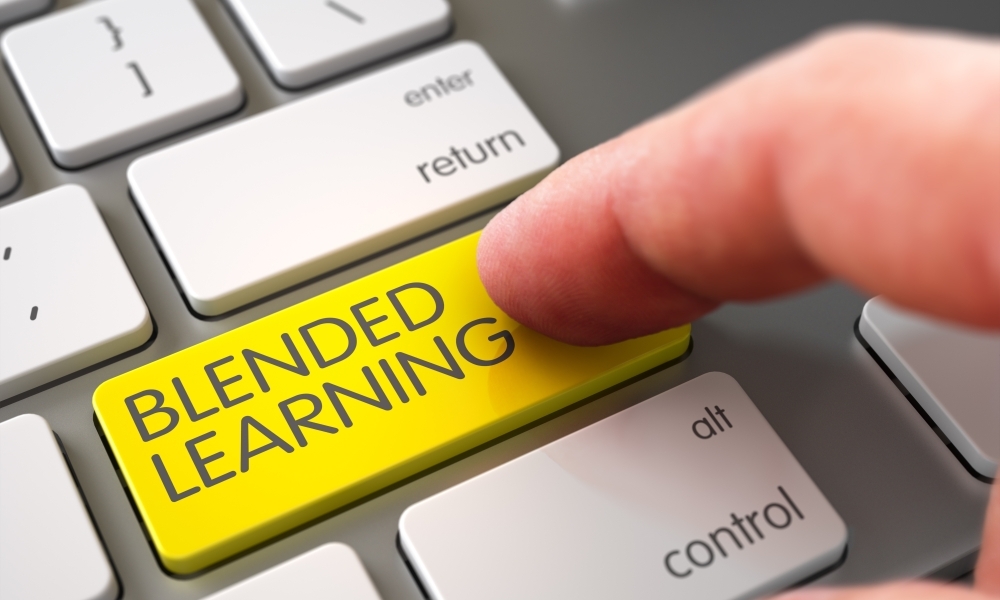Like all areas of life, last year was a challenging one in education but it was also a year of important learning and growth – and not just for students!
The shift to remote learning required educators to change how they approached learning and teaching, with the majority of schools moving to some form of online learning and teaching program. For some schools, this shift was a radical change, whilst for others it was an acceleration of ideas and practices already in place.
Either way, for many it led to new conversations about the possibilities of Blended Learning as a more integral aspect of regular learning and teaching programs.
Blended Learning in a school context
Blended Learning involves the combination of face-to-face, non-digital learning with supportive digital or online activities. Most research on Blended Learning has been conducted in higher education contexts, where it is relatively common (Anthonysamy et al., 2020), so there is a gap in our understanding about how to design and implement effective Blended Learning in the Prep-Year 12 context – see the Education Endowment Foundation report on remote learning (2020) for a summary of some reviews.
During remote learning, many schools reported anecdotally that an increase in the use of digital teaching and learning experiences promoted a range of positive learning outcomes for diverse students, with the Executive Director of Independent Schools Queensland (ISQ) David Robertson commenting: ‘Most schools did an exceptional job in providing online learning during the early stages of 2020 and this, coupled with high levels of pastoral care and strong communities, [was] welcomed by parents (Independent Schools Queensland, 2021).’
Understandably, much discussion has since followed about the future of education, with some pertinent questions emerging, such as:
- What should or does effective Blended Learning look like?
- For which students and under what conditions can Blended Learning be effective?
- How can Blended Learning be best utilised to support effective learning and teaching in Queensland schools?
An in-school research partnership program
These questions led to the establishment of an important in-school research partnership program between ISQ and the Science of Learning Research Centre (SLRC) at The University of Queensland (UQ). Josephine Wise, Director (Education Services) at ISQ states that, ‘Blended learning is moving from an emerging to established educative model in schools, which behoves us to support schools with the tools they need to ensure it is done well’.
Based on the SLRC Partner School Program model, and as part of ISQ’s Great Teachers in Independent Schools (GTIS) Leading, Teaching and Learning suite of programs and services, four schools have been selected to engage in a year-long Science of Blended Learning partnership with the SLRC and ISQ. These schools are Brisbane Adventist College in Mansfield, Good Shepherd Lutheran College in Noosa, Sheldon College in Brisbane’s Bayside, and Saint Stephen’s College in Coomera.
The aim of the partnership is to support the schools to investigate, evaluate and/or adopt a Blended Learning approach as a core part of their pedagogical practices. Through a series of professional learning workshops facilitated by the SLRC Partner Schools Team and ISQ, each school is being supported to identify a focus area, draw on relevant research, build knowledge and skill in school-based research methods, develop an action plan for sustainable improvement, evaluate the impact, and share findings with others.
In their first workshop with the SLRC team, the school teams unpacked the reasons they thought investigating Blended Learning was important and valuable to their context. These reasons were referred to as their ‘hunches’ in that first workshop.
They were then supported to begin narrowing their focus to a measurable aspect of their learning and teaching program, and to develop a tool to provide some baseline data from which to build their project focus. The data from this tool was valuable in confirming some of their hunches, but also revealed some surprising or unexpected findings that could benefit from further exploration.
This data was used as a springboard for a planning workshop at UQ at the beginning of May, where the schools also worked with the university’s Dr Cam Brooks, an expert in feedback, and Professor Tisha Morrell, Head of UQ School of Education. Over the course of the two days, each school team was supported to build their knowledge of the focus area and research design, culminating in the sharing of their action plans to the group at the end of the second day.
School-based research investigations
Briefly, over the coming months each of the schools will be undertaking the following research in their schools:
Saint Stephen’s College are investigating how feedback can be enhanced in a Blended Learning environment, with a focus on short-term goal setting. Drawing upon Brooks et al.’s (2021) student-centred model of feedback as well as Hattie and Timperley’s (2007) four stages of feedback, the St Stephen’s team will be investigating how effective goal setting can be utilised in Blended Learning environments. With a focus on maths in Years 4, 7, and 9, this study aims to help students identify what support they need and what strategies to use when faced with a challenging task (feedback at the Process and Self-Regulatory levels).
Sheldon College’s audit tool revealed that there is a need to develop student awareness of self-regulatory skills in order to more effectively engage in Blended Learning experiences. Blended Learning approaches can provide students with greater perceived sense of autonomy, but autonomy can come with challenges (Azevedo et al., 2008; Donelan & Kear, 2018). Effective learning in a blended environment requires explicit instruction and opportunity to apply skills in self-regulation, metacognition, self-motivation, and time management (Blau et al., 2020; Wang et al., 2020; Green et al., 2014). The Sheldon project will draw on Zimmerman’s (2002) Three-Phase Model of Self-Regulated Learning to investigate the impact of an intervention on student capacity to actively monitor and regulate their own learning in a blended learning environment.
Good Shepherd Lutheran College are interested in the range of ways teachers reported using what they considered blended approaches. An initial look at some of these approaches was provided by their audit tool. Their project will collate illustrations of Blended Learning practice from across the College and will investigate ways in which these approaches may be adapted across the curriculum to encourage higher order thinking skills, drawing upon Marzano and Kendall’s (2007) four levels of cognitive process: retrieval, comprehension, analysis and knowledge utilisation as utilised by the Queensland Curriculum and Assessment Authority.
Brisbane Adventist College are interested in how to promote student-centred feedback in Blended Learning environments. Their audit tool revealed that a large number of students lack confidence in using marking criteria to assess their learning progress. Drawing on Brooks et al.’s (2021) student-centred model of feedback, the Brisbane Adventist intervention study aims to build student ability and self-efficacy in critiquing model assessments using Blended Learning platforms.
Sharing the project findings
The Science of Blended Learning Partnership between the SLRC, ISQ and the four schools will continue for the remainder of the year, with each school being supported by the SLRC and ISQ team to develop, implement, and evaluate their interventions, and share their findings.
These projects will contribute to our understanding of different ways in which Blended Learning can be effectively embedded into core pedagogical approaches. We will follow the schools as they work through their projects and share their findings at the conclusion.
We would like to acknowledge the Science of Blended Learning research teams as well as the Leadership teams, teaching staff, students and broader community from Brisbane Adventist College, Good Shepherd Lutheran College, Sheldon College, and Saint Stephen’s College for their participation in and support of the projects.
References
Anthonysamy, L., Koo, A. C., & Hew, S. H. (2020). Self-Regulated Learning Strategies in Higher Education: Fostering Digital Literacy for Sustainable Lifelong Learning. Education and Information Technologies, 25(4), 2393–2414. https://doi.org/10.1007/s10639...
Azevedo, R., Moos, D. C., Greene, J. A., Winters, F. I., & Cromley, J. G. (2008). Why is externally-facilitated regulated learning more effective than self-regulated learning with hypermedia?. Educational Technology Research and Development, 56(1), 45-72.
Blau, I., Shamir-Inbal, T., & Avdiel, O. (2020). How does the pedagogical design of a technology-enhanced collaborative academic course promote digital literacies, self-regulation, and perceived learning of students? The Internet and Higher Education, 45, 100722. https://doi.org/10.1016/j.iheduc.2019.100722
Brooks, C., Burton, R., van der Kleij, F., Carroll, A., Olave, K., & Hattie, J. (2021). From fixing the work to improving the learner: An initial evaluation of a professional learning intervention using a new student-centred feedback model. Studies in Educational Evaluation, 68, 100943. https://doi.org/10.1016/j.stueduc.2020.100943
Donelan, H., & Kear, K. (2018). Creating and Collaborating: Students’ and Tutors’ Perceptions of an Online Group Project. International Review of Research in Open and Distributed Learning, 19(2), 37–54. https://doi.org/10.19173/irrod...
Education Endowment Foundation (2020) Remote Learning, Rapid Evidence Assessment. https://www.evidenceforlearnin... (PDF 768KB)
Greene, J. A., Seung, B. Y., & Copeland, D. Z. (2014). Measuring critical components of digital literacy and their relationships with learning. Computers & Education, 76, 55-69. https://doi.org/10.1016/j.comp...
Hattie, J., & Timperley, H. (2007). The power of feedback. Review of educational research, 77(1), 81-112. https://doi.org/10.3102/003465...
Independent Schools Queensland. (2021). Briefings: Thought leadership for the independent schooling sector, 25(2). https://www.isq.qld.edu.au/med... (PDF, 899KB)
Marzano, R., & Kendall, J. (2007) The New Taxonomy of Educational Objectives. Corwin Press.
Wang, C., Hsu, H. C. K., Bonem, E. M., Moss, J. D., Yu, S., Nelson, D. B., & Levesque-Bristol, C. (2019). Need satisfaction and need dissatisfaction: A comparative study of online and face-to-face learning contexts. Computers in Human Behavior, 95, 114-125. https://doi.org/10.1016/j.chb....
Zimmerman, B. J. (2002). Becoming a self-regulated learner: An overview. Theory into Practice, 41(2), 64-70. https://doi.org/10.1207/s15430...
As a school leader, have you set aside time for you and your staff to reflect on teaching and learning in your context since the start of the pandemic? How did teachers and students adapt to the increased use of technology and different ways of working? How can you build on this? What are some of the learnings you’ll take into your future practice?



